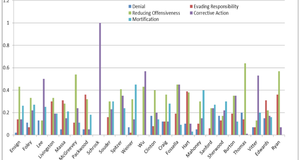As scholars such as Miloch and Brazeal have clearly established with their work, athletes are particularly bound to their public image, making the implementation of effective crisis management strategies that much more imperative. For the purpose of this study, Benoit’s theory of image restoration will be employed to analyze the public statements made by Terrelle Pryor, A.J. Green, Cam Newton, and their respective universities.
Benoit’s theory was chosen largely in part because scholars have established the value of the theory as it relates to professional athletes. For example, Blair Bernstein found that Tiger Woods effectively utilized Benoit’s strategy of mortification to shift media scrutiny away from his sex scandal in 2009.16 In similar fashion, scholars Bruce and Tini found that Australian rugby players relied heavily on Benoit’s strategies during a highly publicized salary cap scandal.17 Thus, his theory is well suited to rhetorically analyze statements made by high-profile individuals, as this study aims to do.
Before proceeding into the outline of Benoit’s theory, it is important to recognize the distinction between the terms “crisis management” and “image restoration.” The two are often used interchangeably, but it is worth noting that image restoration falls under the umbrella of crisis management. That being said, the two terms will be used interchangeably within this paper, as image restoration efforts by the athletes and associated parties are its primary analytic focus.
Benoit breaks his image restoration strategies into five broad categories: denial, evading responsibility, reducing offensiveness, corrective action, and mortification. These categories are not mutually exclusive, and feature sub-strategies as well.
Benoit cites several authors in noting that the individual in question can either deny that the event in question ever occurred or deny the fact that they are guilty for it. The individual in question may also utilize evidence, alibis, or pertinent information to add further weight to their denial. Benoit also cites the passing of blame as an important, and often more effective, variant of denial.
When denial of a certain act is not viable, which is often the case, evading responsibility for it becomes the next viable option. The first of four strategy variations is asserting that the accused party was provoked into their actions by another wrongful act. In this way, the accused individual justifies their own actions by passing blame onto another party and reducing their own responsibility.
Benoit defines the second variation, defeasibility, as “pleading lack of information about or control over important factors in the situation.” Thus, the accused attempts to reduce their responsibility by affirming that they did not have sufficient information or control to handle the situation effectively.
The third variation of evading responsibility relies on accidents and aims to pass the blame to their arbitrary nature. The fourth and final variation of this strategy does not particularly evade responsibility, but rather attributes it to good intentions.
The third image restoration strategy employed by Benoit is reducing offensiveness. An accused individual may attempt to reduce “the degree of ill feeling experienced by the audience” through six methods: bolstering, minimization, differentiation, transcendence, attacking one’s accuser, and compensation.
Bolstering is one of the more common strategies used by individuals when responding to a crisis, as studies of superstar athletes such as Terrell Owens and Tiger Woods clearly show.18 The bolstering method attempts to increase positive sentiments towards the accused individual by highlighting past actions or positive attributes.
Minimization, on the other hand, attempts to convince the audience that the event in question is not as damaging or scandalous as it has been made out to be. Differentiation aims to achieve a similar effect with the audience by comparing it to similar, yet more notorious acts. Similarly, the fourth variation of this strategy, transcendence, attempts to reduce offensiveness by putting the event in question into a different context. While the individual may seem at fault in the initial frame of reference, this method aims to alleviate feelings of ill will by shifting the perception of the audience.
The fifth variation of reducing offensiveness aims to attack the accusers. The accused individual will allege that the accusers deserved what happened or that they were in some way responsible.
The sixth and final variation of this strategy is compensation. Compensation is very straightforward in that the accused individual offers some type of reimbursement to reduce sentiments of ill will.
Corrective action, Benoit’s fourth image restoration strategy, involves the accused individual promising to fix the problem. This corrective action can take one of two forms: the individual can work to return things to the way they were before the incident in question, or the individual can make assurances of adjustments that will prevent any similar incidents from occurring in the future.
Benoit’s fifth and final component of his image restoration theory is mortification. Mortification is the most direct of the aforementioned strategies, as the accused individual admits responsibility for the actions in question and seeks forgiveness for them. Benoit adds as a side note that mortification also couples effectively with corrective action.
Benoit cites these five strategies and their associated variants as options for individuals or parties seeking to mend their public reputation. Using this theory as a basis, this study will aim to see which image restoration strategies high-profile college athletes are employing and the implications associated with these actions.
In order to grasp the worth of this study and the void in established literature it aims to fill, it is necessary to outline the backdrop behind the scandals of high-profile college athletes. By understanding the world of college athletics and how it has evolved in recent time, the reader can better understand why scandals have become more commonplace and, to a greater extent, why the crisis management efforts of these athletes are so important.
The fame and profitability of modern college athletics are not mutually exclusive; the two are deeply interwoven in a reciprocal relationship. As profits increase from television deals, merchandising, and other lucrative sources, the scope of college athletics only broadens further. Thus, the finances behind the current college athletic landscape speak volumes regarding its national status.
The gargantuan profits behind modern college athletics can be seen along the entire spectrum. Take, for example, one of the focuses of this study: Cam Newton, former quarterback for Auburn University. During his improper benefits scandal (which will be outlined later in this section), Newton wore 15 corporate logos while on the field, ranging all the way from his helmet to his cleats, as part of the university’s $10.6
million deal with Under Armour. Auburn happens to be part of the illustrious Southeastern Conference, which became the first individual athletic league to crack the billion-dollar mark. Not far behind, the Big Ten athletic conference netted just over $900 million that same year. Members of these conferences, such as Penn State, Michigan, and Georgia, earn between $40 and $80 million in profits each year from athletics, after they pay their coaches multi-million dollar contracts. These figures stem from a number of sources, including ticket sales, concession sales, licensing fees, and, most of all, network television contracts. These profits are then distributed to a multitude of associated parties, including the NCAA organization, the University, the respective athletic organization, and television networks. Secondary parties, such as retail and tourism destinations, also benefit financially from the presence of successful college athletic programs.
In December of 2005, the Commerce, Trade, and Consumer Protection Sub-Committee referred to college football as “big business.” While it is important to recognize where all of this money goes, it is just as important, if not more, to take note of where it does not go. While every party even vaguely associated with college athletic programs consistently earns high-grossing profits, the athletes themselves make nothing at all. This comes as a result of the NCAA’s stance and regulations regarding the sanctity of the “studentathlete” and “amateurism.” The payment, or lack thereof, of college athletes has become a philosophical, financial, and legal debate. Opinions aside, this polarizing situation helps shed light on why scandals have become increasingly present within the world of college athletics. As Branch puts it, “when you combine so much money with such high, almost tribal, stakes, corruption is likely to follow.”Continued on Next Page »
“A.J. Green’s eligibility still at issue with NCAA, source says ESPN.” ESPN: The Worldwide Leader In Sports. N.p., n.d. Web. 15 Apr. 2013.
“A.J. Green’s Playing Status Clarified The University of Georgia Bulldogs .”University of Georgia Athletics. N.p., n.d. Web. 23 Apr. 2013. georgiadogs.com/sports/m-footbl/spec-rel/090810aad. html>.
“A.J. Green Profile The University of Georgia Bulldogs .” University of Georgia Athletics. N.p., n.d. Web. 21 Apr. 2013. georgiadogs.com/sports/m-footbl/mtt/green_aj00.html>.
“A.J. Green: I sold jersey for ‘extra cash’ during spring break | UGA sports blog.” Blogs about Atlanta news, sports and more | ajc.com, accessAtlanta.com. N.p., n.d. Web. 23 Apr. 2013.
“Auburn Tigers’ Cam Newton eligible to play, NCAA says ESPN.” ESPN: The Worldwide Leader In Sports. N.p., n.d. Web. 15 Apr. 2013.
“Auburn’s Cam Newton: I’ve done nothing wrong NCAA Football Sporting News.” Sporting News Real Insight. Real Fans. Real Conversations.. N.p., n.d. Web. 23 Apr. 2013.
Benoit, William L.. Accounts, Excuses, and Apologies: a Theory of Image Restoration Strategies. Albany: State University of New York Press, 1995. Print.
Bernstein, Blair. “Crisis Management and Sports in the Age of Social Media: A Case Study Analysis of the Tiger Woods Scandal.” The Elon Journal of Undergraduate Research in Communications 3.2 (2012): 62-75. Elon University. Web. 2 Mar. 2013.
Branch, Taylor. “The Shame of College Sports Magazine The Atlantic.” The Atlantic — News and analysis on politics, business, culture, technology, national, international, and life â TheAtlantic.com. N.p., n.d. Web. 1 Dec. 2011. .theatlantic.com/magazine/archive/1969/12/the-shame-of-collegesports/8643/>.
Brazeal, LeAnn. “The Image Repair Strategies of Terrell Owens.” Public Relations Review 34.2 (2008): 145-150. Sciencedirect.com. Web. 6 Mar. 2013.
Bruce T, Tini T. Unique crisis response strategies in sports public relations: Rugby league and the case for diversion. Public Relations Review [serial online]. June 2008;34(2):108-115. Available from: Communication & Mass Media Complete, Ipswich, MA. Accessed March 6, 2013.
“Cam Newton | Auburn, QB : 2011 NFL Draft Scout Player Profile.» 2013 NFL Draft CBSSports.com NFL-DraftScout.com. N.p., n.d. Web. 21 Apr. 2013. http://www.nfldraftscout.com/ratings/dsprofile.php?pyid=71142&draftyear=2011&genpos=qb
“Cam Newton confident in his actions at Auburn ESPN.” ESPN: The Worldwide Leader In Sports. N.p., n.d. Web. 23 Apr. 2013.
“Cam Newton Scandal: Rep Sought Cash from MSU CBS News.” Breaking News Headlines: Business, Entertainment & World News CBS News. N.p., n.d. Web. 15 Apr. 2013. cbsnews. com/2100-500290_162-7025408.html>.
Carter, Andrew. “Terrelle Pryor apologizes to Ohio State: Former Buckeyes quarterback Terrelle Pryor apologizes to Ohio State for scandal Sun Sentinel.” Featured Articles From The Sun Sentinel. Sun Sentinel, n.d. Web. 9 Apr. 2013. 1-06-14/sports/fl-terrelle-pryorapologizes-ohio-sta20110614_1_terrelle-pryor-jim-tressel-ohio-state>.
Castel, Brandon. “Timeline on NCAA investigation.” NEWS. Ohio State Football, Basketball, Hockey, Baseball, Wrestling, Softball, and More. N.p., n.d. Web. 21 Apr. 2013. the-ozone.net/football/2010/SugarBowl/NCAAtimeline.htm
“College Football Bowl Games: Millions on the Line | AccountingWEB.com.” AccountingWEB.com | Your Profession. Your Community.. N.p., n.d. Web. 1 Dec. 2011. .accountingweb.com/item
Coombs, W. Timothy. Ongoing Crisis Communication: Planning, Managing, and Responding. Thousand Oaks: Sage Publications, 1999. Print.
“ESPN.com Terrelle Pryor addresses scandal .” ESPN: The Worldwide Leader In Sports. N.p., n.d. Web. 23 Apr. 2013.
Fink, S. (1986). Crisis management: Planning for the inevitable. New York, NY: Amacom.
“Five Ohio State Buckeyes, including Terrelle Pryor, must sit out five games in ‘11 ESPN.” ESPN: The Worldwide Leader In Sports. N.p., 26 Dec. 2010. Web. 21 Apr. 2013.
Fowler, Jeremy. “Backup QB Cameron Newton arrested for stealing laptop, suspended from team – Swamp Things – Gators Blog – Orlando Sentinel.” Orlando Sentinel Blogs OrlandoSentinel.com. N.p., n.d. Web. 21 Apr. 2013. 1/backup-qb-camer. html>.
Goldberg, Charles. “Auburn’s Cam Newton timeline: From recruitment to NCAA ruling | al.com.” Alabama Local News, Breaking News, Sports & Weather al.com. N.p., n.d. Web. 21 Apr. 2013. Halley, Jim. “The 2007 All-USA players, coach of the year.” USA Today. Retrieved 2008-04-27.
“Kenny Rogers: Cecil Newton put price tag on Cam Newton for Mississippi State ESPN.” ESPN: The Worldwide Leader In Sports. N.p., n.d. Web. 21 Apr. 2013.
Mahoney, Jon. “Green headlines top 10 football players in Class of ‘08 Friday August 4, 2006 3:08PM.” SI.com. N.p., n.d. Web. 21 Apr. 2013. http://sportsillustrated.cnn.com/2006/highschool/08/04/top10. football08/index.html
Millar, Dan Pyle, and Robert L. Heath. Responding to Crisis a Rhetorical Approach to Crisis Communication. Mahwah, N.J.: Lawrence Erlbaum, 2004. Print.
“NCAA investigating Auburn QB Cam Newton’s recruitment NCAA Football Sporting News.” Sporting News Real Insight. Real Fans. Real Conversations.. N.p., n.d. Web. 21 Apr. 2013.
Ohio State Buckeyes vs. Oregon Ducks Box Score January 01, 2010 ESPN.” ESPN: The Worldwide Leader In Sports. N.p., n.d. Web. 18 Apr. 2013.
Pedersen, Paul Mark, Kimberly S. Miloch, and Pamela C. Laucella. Strategic sport communication. Champaign, IL: Human Kinetics, 2007. Print.
“Pryor announcement to be most anticipated in history.” CNN. 2008-02-05. Retrieved 4/18/13
“Scout.com: Cam Newton Profile.” Florida Gators Football, Basketball, and Recruiting Front Page. N.p., n.d. Web. 21 Apr. 2013.
Teitelbaum, S. H. (2010). Athletes who indulge their dark side: Sex, drugs and cover-ups. Santa Barbara, CA: ABC-CLIO.
“Terrelle Pryor apologizes, will enter supplemental draft ESPN.” ESPN: The Worldwide Leader In Sports. N.p., n.d. Web. 21 Apr. 2013.
Tucker, Tim. “A.J. Green: I sold jersey for ‘extra cash’ during spring break | UGA sports blog.” Blogs about Atlanta news, sports and more | ajc.com, accessAtlanta.com. N.p., n.d. Web. 15 Apr. 2013.
“Watch Texas Longhorns Live Sports Events and Programs Longhorn Network.” ESPN: The Worldwide Leader In Sports. ESPN, n.d. Web. 15 Apr. 2013.
Weir, Tom. “A look at some of college football’s biggest scandals.” USA TODAY: Latest World and US News USATODAY.com. N.p., 23 July 2011. Web. 6 Mar. 2013. com/communities/ gameon/post/2011/08/miami-hurricanes-ncaa-scandals-football-history/1#.UTa1QqU1751>.
“WKEF-TV ABC 22 News :: News Raw News Terrelle Pryor’s Raw press conference clip.” WKEF-TV ABC 22 News :: Dayton, Ohio Local and National News. N.p., n.d. Web. 23 Apr. 2013. abc-22now.com/shared/news/features/raw-news/stories/wkef_vid_45.shtm
Endnotes
1. Taylor Branch, “The Shame of College Sports Magazine The Atlantic.” The Atlantic — News and analysis on politics, business, culture, technology, national, international, and life â TheAtlantic.com. N.p., n.d. Web. 1 Dec. 2011. < theatlantic.com/magazine/archive/1969/12/the-shame-of-college-sports/8643/ >.
2. Taylor Branch, “The Shame of College Sports Magazine The Atlantic.” The Atlantic, College Football Bowl Games: Millions on the Line | AccountingWEB.com.” AccountingWEB.com | Your Profession. Your Community.. N.p., n.d. Web. 1 Dec. 2011. accountingweb.com/item
3. Analyzed works include: Responding to Crisis: A Rhetorical Approach to Crisis Communication by Dan P. Milar and Robert L. Heath, Ongoing Crisis Communication: Planning, Managing, and Responding by W. Timothy Coombs.
4. Dan P. Milar and Robert L. Heath. Responding to Crisis a Rhetorical Approach to Crisis Communication. pg. 2.
5. Timothy W. Coombs, Ongoing Crisis Communication: Planning, Managing, and Responding. Thousand Oaks: Sage Publications, 1999. Print. Pg. 2.
6. Steven Fink, Crisis management: Planning for the inevitable. New York, NY: AMACOM, re-quoted by Dan P. Milar and Robert L. Heath. Responding to Crisis a Rhetorical Approach to Crisis Communication. pg. 2.
7. Dan P. Milar and Robert L. Heath. Responding to Crisis a Rhetorical Approach to Crisis Communication.
8. Dan P. Milar and Robert L. Heath. Responding to Crisis a Rhetorical Approach to Crisis Communication. pg. 5-9
9. Toni Bruce and Tahlila Tini, Unique crisis response strategies in sports public relations: Rugby league and the Case for Diversion. Public Relations Review [serial online]. June 2008;34(2):108-115. Available from: Communication & Mass Media Complete, Ipswich, MA. Accessed March 6, 2013.
10. LeAnn Brazeal, “The Image Repair Strategies of Terrell Owens.” Public Relations Review 34.2 (2008): 145-150. Sciencedirect.com. Web. 6 Mar. 2013.
11. Mark P. Pedersen, Kimberly S. Miloch, and Pamela C. Laucella. Strategic Sport Communication. Champaign, IL: Human Kinetics, 2007. Print.
12. LeAnn Brazeal, “The Image Repair Strategies of Terrell Owens.” pg. 145.
13. Toni Bruce and Tahlila Tini, Unique crisis response strategies in sports public relations: Rugby league and the case for diversion, LeAnn Brazeal, “The Image Repair Strategies of Terrell Owens.”
14. LeAnn Brazeal, “The Image Repair Strategies of Terrell Owens.” pg. 146.
15. This citation encompasses the following section: William L. Benoit, Accounts, Excuses, and Apologies: Theory of Image Restoration Strategies.Albany: State University of New York Press, 1995. Print.
16. Blair Bernstein, “Crisis Management and Sports in the Age of Social Media: A Case Study Analysis of the Tiger Woods Scandal.”
17. Toni Bruce and Tahlila Tini, "Unique crisis response strategies in sports public relations."
18. Blair Bernstein, “Crisis Management and Sports in the Age of Social Media."
19. The following section utilizes information from: Taylor Branch, “The Shame of College Sports Magazine The Atlantic.” The Atlantic — News and analysis on politics, business, culture, technology, national, international, and life â TheAtlantic.com. N.p., n.d. Web. 1 Dec. 2011 .theatlantic.com/magazine/ archive/1969/12/the-shame-of-college-sports/8643/>.
20. “Pryor announcement to be most anticipated in history.” CNN. 2008-02-05. Retrieved 4/18/13.
21. “Ohio State Buckeyes vs. Oregon Ducks Box Score January 01, 2010 ESPN.” ESPN: The Worldwide Leader In Sports. N.p., n.d. Web. 18 Apr. 2013.
22. Brandon Castel, “Timeline on NCAA investigation.” NEWS. Ohio State Football, Basketball, Hockey, Baseball, Wrestling, Softball, and More. N.p., n.d. Web. 21 Apr. 2013. the-ozone.net/football/2010/ SugarBowl/NCAAtimeline.htm
23. “Five Ohio State Buckeyes, including Terrelle Pryor, must sit out five games in ‘11 ESPN.” ESPN: The Worldwide Leader In Sports. N.p., 26 Dec. 2010. Web. 21 Apr. 2013.
24. The following quotes and information contained in this section were taken from citations 14-16.
25. “Terrelle Pryor apologizes, will enter supplemental draft ESPN.” ESPN: The Worldwide Leader In Sports. N.p., n.d. Web. 21 Apr. 2013.
26. “WKEF-TV ABC 22 News :: News Raw News Terrelle Pryor’s Raw press conference clip.” WKEF-TV ABC 22 News :: Dayton, Ohio Local and National News. N.p., n.d. Web. 23 Apr. 2013. http://www.newsnet5. com/dpp/sports/college_sports/osu/former-osu-quarterback-terrelle-pryor-apologizes-to-tressel-teammatesfans
27. Andrew Carter, “Terrelle Pryor apologizes to Ohio State: Former Buckeyes quarterback Terrelle Pryor apologizes to Ohio State for scandal Sun Sentinel.” Featured Articles From The Sun Sentinel. Sun Sentinel, n.d. Web. 9 Apr. 2013. 1-06-14/sports/fl-terrelle-pryor-apologizes-ohiosta20110614_1_terrelle-pryor-jim-tressel-ohio-state>.
28. Benoit, William L.. Accounts, Excuses, and Apologies: a Theory of Image Restoration Strategies. Pgs.74-82.
29. “A.J. Green Profile The University of Georgia Bulldogs .” University of Georgia Athletics. N.p., n.d. Web. 21 Apr. 2013. georgiadogs.com/sports/m-footbl/mtt/green_aj00.html>.
30. The following quotes and information contained in this section were taken from citations 21-22.
31. Tim Tucker. “A.J. Green: I sold jersey for ‘extra cash’ during spring break | UGA sports blog.” Blogs about Atlanta news, sports and more | ajc.com, accessAtlanta.com. N.p., n.d. Web. 15 Apr. 2013.
32. “A.J. Green’s Playing Status Clarified The University of Georgia Bulldogs .”University of Georgia Athletics. N.p., n.d. Web. 23 Apr. 2013. < http://www.georgiadogs.com/sports/m-footbl/spec-rel/090810aad.html >.
33. Cam Newton | Auburn, QB : 2011 NFL Draft Scout Player Profile.» 2013 NFL Draft CBSSports.com NFL- DraftScout.com. N.p., n.d. Web. 21 Apr. 2013. http://www.nfldraftscout.com/ratings/dsprofile.php?pyid=71142&draftyear=2011&genpos=qb
34. Charles Goldberg, “Auburn’s Cam Newton timeline: From recruitment to NCAA ruling | al.com.” Alabama Local News, Breaking News, Sports & Weather al.com. N.p., n.d. Web. 21 Apr. 2013.
35. “NCAA investigating Auburn QB Cam Newton’s recruitment NCAA Football Sporting News.” Sporting News Real Insight. Real Fans. Real Conversations.. N.p., n.d. Web. 21 Apr. 2013.
36. “Kenny Rogers: Cecil Newton put price tag on Cam Newton for Mississippi State ESPN.” ESPN: The Worldwide Leader In Sports. N.p., n.d. Web. 21 Apr. 2013.
37. “Report: Cam Newton, father admitted pay-for-play plan NCAA Football Sporting News.” Sporting News Real Insight. Real Fans. Real Conversations.. N.p., n.d. Web. 21 Apr. 2013.
38. The following quotes and information contained in this section were taken from citations 31-33.
39. “Auburn’s Cam Newton: I’ve done nothing wrong NCAA Football Sporting News.” Sporting News Real Insight. Real Fans. Real Conversations.. N.p., n.d. Web. 23 Apr. 2013.
40. “Cam Newton confident in his actions at Auburn ESPN.” ESPN: The Worldwide Leader In Sports. N.p., n.d. Web. 23 Apr. 2013.
41. “Auburn Tigers’ Cam Newton eligible to play, NCAA says ESPN.” ESPN: The Worldwide Leader In Sports. N.p., n.d. Web. 15 Apr. 2013.




















